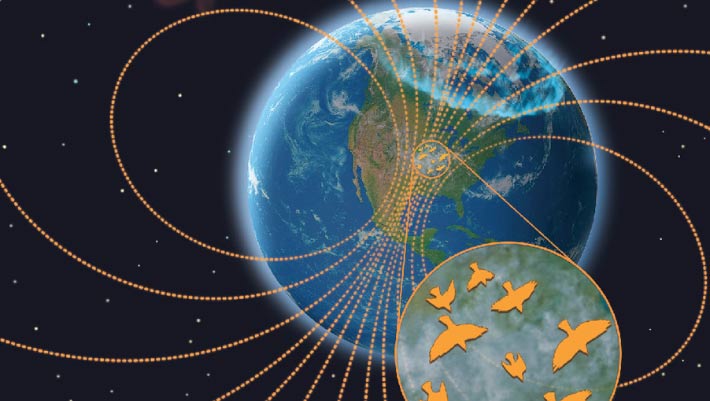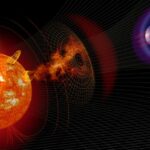Earth’s magnetic field is occasionally but regularly impacted by bursts of energy from the Sun (space weather), such as coronal mass ejections. Birds and other animals depend on the geomagnetic field for long-distance navigation during their seasonal migrations. In new research, scientists from the University of Michigan and elsewhere used long-term datasets to test whether geomagnetic disturbance is correlated with the number of birds migrating, their effort flying against the wind, and their flight altitude. Their results, published in the Proceedings of the National Academy of Sciences, suggest that fewer birds migrate during strong geomagnetic disturbances and that migrating birds may experience more difficulty navigating, especially under overcast conditions in autumn.
Space weather from the Sun, such as coronal mass ejections, disturbs Earth’s magnetic field, causing the aurorae and potentially decreasing the magnetic field’s reliability for migrating birds. Image credit: John Megahan.
Earth’s magnetic field is regularly impacted by solar outbursts that can trigger colorful aurorae and that sometimes disrupt satellite communications, human navigation systems and power grids.
But little is known about how those disturbances affect animals that depend on the geomagnetic field for migratory orientation and navigation.
Previous experimental studies over several decades provide strong evidence that birds, sea turtles and other organisms key into small changes in magnetic inclination, intensity and declination when making orientation decisions and developing navigational maps.
One recent study examined millions of bird banding records and found that geomagnetic disturbances were associated with increased incidence of migratory bird ‘vagrancy,’ that is, birds becoming lost during migration.
But most previous studies were narrowly focused in geographic extent, duration and the number of species examined.
In contrast, University of Michigan researcher Eric Gulson-Castillo and colleagues used a 23-year dataset of bird migration across the U.S. Great Plains to provide new insights at population and landscape levels.
They used images collected at 37 NEXRAD radar stations in the central flyway of the U.S. Great Plains, a major migratory corridor. The flyway spans more than 1,600 km (1,000 miles) in the U.S., from Texas to North Dakota.
They selected this relatively flat region to minimize influences from mountainous topography or oceanic and Great Lakes coastlines.
Their final datasets included 1.7 million radar scans from the fall and 1.4 million from the spring.
The community of nocturnally migrating birds in this region is primarily composed of a diverse set of perching birds (Passeriformes, 73% of species) such as thrushes and warblers; shorebirds (Charadriiformes, 12%) such as sandpipers and plovers; and waterfowl (Anseriformes, 9%) such as ducks, geese and swans.
The NEXRAD radar scans detect groups of hundreds to thousands of migrating birds.
Migration intensity — meaning the number of birds in each cluster — can be estimated and direction of flight can be measured.
Concurrent geomagnetic measurements were accessed through superMAG, a worldwide collection of geomagnetic ground stations. Data were collected from magnetometer stations near weather radar sites.
The researchers matched data from each radar station with a customized, spatiotemporally explicit index of geomagnetic disturbance that represents the maximum hourly change from background magnetic conditions.
The data trove was fed into two complementary statistical models to measure the putative effects of magnetic disturbances on bird migration.
The models controlled for the known effects of weather, temporal variables such as time of night and geographic variables such as longitude and latitude.
“We found broad support that migration intensity decreases under high geomagnetic disturbance,” said University of Michigan’s Dr. Ben Winger.
“Our results provide ecological context for decades of research on the mechanisms of animal magnetoreception by demonstrating community-wide impacts of space weather on migration dynamics.”
The scientists also found that migrating birds appear to drift with the wind more frequently during geomagnetic disturbances in the fall, instead of expending great effort to battle crosswinds.
‘Effort flying’ against the wind was reduced by 25% under cloudy skies during strong solar storms in the fall, suggesting that a combination of obscured celestial cues and magnetic disruption may hinder navigation.
“Our results suggest that fewer birds migrate during strong geomagnetic disturbances and that migrating birds may experience more difficulty navigating, especially under overcast conditions in autumn,” Gulson-Castillo said.
“As a result, they may spend less effort actively navigating in flight and consequently fly in greater alignment with the wind.”
_____
Eric R. Gulson-Castillo et al. 2023. Space weather disrupts nocturnal bird migration. PNAS 120 (42): e2306317120; doi: 10.1073/pnas.2306317120




